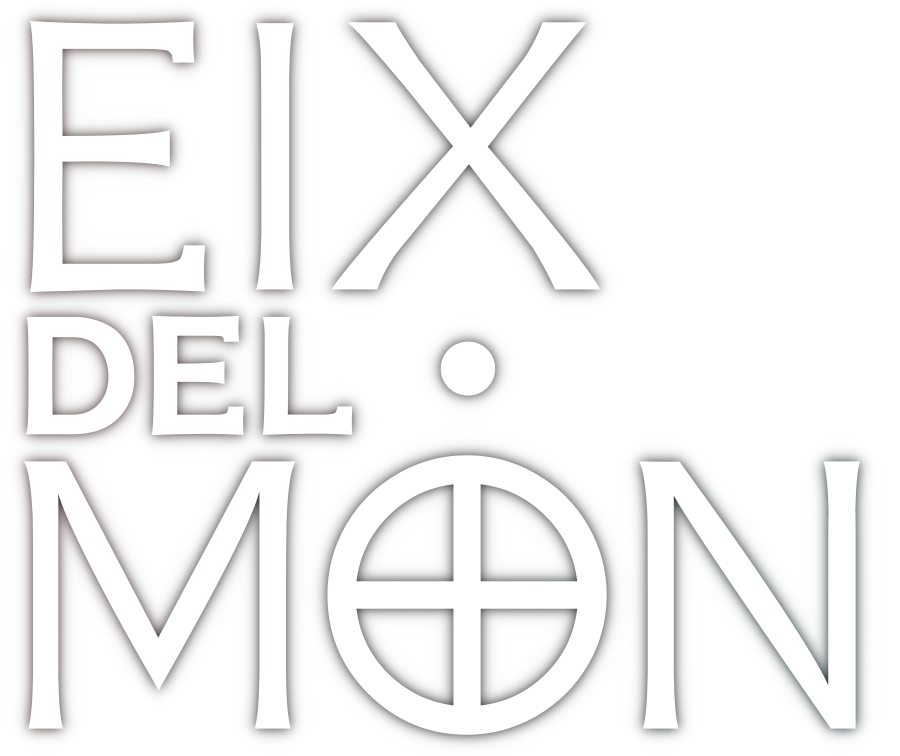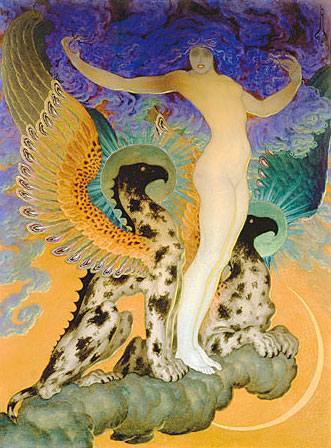“Astarte” by Nicholas Kalmakoff. 1926. The website Visionary Revue has an 18 page article on the artist here.
The project Ancient Mesopotamian Gods and Goddesses has an entry on Inana/Ištar, which reads:
Inana (Sumerian)/Ištar (Akkadian) is among the most important deities and the most important goddess in the Mesopotamian pantheon. She is primarily known as the goddess of sexual love but is equally prominent as the goddess of warfare. In her astral aspect, Inana/Ištar is the planet Venus, the morning and the evening star.
Inana/Ištar is by far the most complex of all Mesopotamian deities, displaying contradictory, even paradoxical traits (Harris 1991; see also Bahrani 2000). In Sumerian poetry, she is sometimes portrayed as a coy young girl under patriarchal authority (though at other times as an ambitious goddess seeking to expand her influence, e.g., in the partly fragmentary myth Inana and Enki, ETCSL 1.3.1 and in the myth Inana’s Descent to the Netherworld, ETCSL 1.4.1). Her marriage to Dumuzi is arranged without her knowledge, either by her parents or by her brother Utu (Jacobsen 1987: 3). Even when given independent agency, she is mindful of boundaries: rather than lying to her mother and sleeping with Dumuzi, she convinces him to propose to her in the proper fashion (Jacobsen 1987: 10). These actions are in stark contrast with the portrayal of Inana/Ištar as a femme fatale in the Epic of Gilgameš. Taken by the handsome Gilgameš, Inana/Ištar invites him to be her lover. Her advances, however, are rejected by the hero who accusingly recounts a string of past lovers she has cast aside and destroyed (Dalley 2000: 77ff).
Astarte was connected with fertility, sexuality, and war. Her symbols were the lion, the horse, the sphinx, the dove, and a star within a circle indicating the planet Venus. Pictorial representations often show her naked. She has been known as the deified evening star.
- B. Becking, P. W. Van der Horst, and K. Van der Toorn, Dictionary of Deities and Demons in the Bible, 2nd ed., William B. Eerdmans Publishing Company, 1999.
[Bibtex]@Book{dictionaryOfDeitiesAndDemons1999, author = {{Becking}, Bob. and {Van der Horst}, Pieter W. and {Van der Toorn}, Karel}, title = {Dictionary of Deities and Demons in the Bible}, year = {1999}, edition = {2nd}, note = {Dimensions: 263.14 × 188.21 × 58.93 mm Weight: 1.84 kg}, publisher = {William B. Eerdmans Publishing Company}, url = {http://www.angusrobertson.com.au/books/dictionary-of-deities-and-demons-in-the-bible/p/9780802824912#productAttributes}, comment = {Read it online in http://www.scribd.com/doc/211289883/Dictionary-of-Deities-and-Demons-in-the-Bible#scribd}, file = {dictionaryOfDeitiesAndDemons1999.pdf:dictionaryOfDeitiesAndDemons1999.pdf:PDF}, keywords = {religion}, review = {The Dictionary of Deities and Demons in the Bible (DDD) is the single major reference work on the gods, angels, demons, spirits, and semidivine heroes whose names occur in the biblical books.}, timestamp = {2016-07-28}, }




